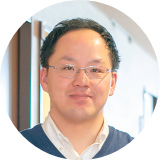INTERVIEW
2020.3.25
Working and Self-Caring for Mental and Physical Conditions
Kenichi Saito(Age: 39)× Nguyen Ngoc Thuy(Age: 26)
Thuy, from Vietnam, came to ‘Graceful SHIOJIRI,’ an intensive care home for the elderly, in Shiojiri, Nagano as an EPA Care Worker Candidate. She completed a ten-week training program and started working at the facility two years ago.
Kenichi Saito, the head of care workers, has been working with Thuy and thinks that she has a good sense for nursing care. They told us about their opinions about their jobs in the environment with many other Vietnamese care workers.
PROFILE
| Nane | Nguyen Ngoc Thuy |
|---|---|
| Workplace | Care Worker at an intensive care home for the elderly run by SUN-VISION Social Welfare Corporation ‘Graceful SHIOJIRI’ |
| Birthplace | |
| Age | 26 (Born in 1993) |
| Education | Graduated from the College of Nursing at Hanoi Medical College |
| Work Experience | Working as a nurse at a general hospital for 1 year |
| Residence Status at Entry to Japan | EPA Care Worker Candidate |
| Arrival Date in Japan | May 2018 |
| Name | Kenichi Saito |
|---|---|
| Workplace | The Head of Care Workers at an intensive care home for the elderly run by SUN-VISION Social Welfare Corporation ‘Graceful SHIOJIRI’ |
| Birthplace | |
| Age | 39 (Born in 1981) |
| Education | Bachelor of Sociology in Social Welfare at Momoyama Gakuin University |
| Job Starting Date | April 2003 |

Thuy
I often struggle because there are many things on the list. It is fun once you get used to it. For the first six months, I slowly worked with my seniors. I spoke to the residents everyday and got to know each resident’s feelings and personality. Since then, my skills related to nursing care have been improved.

Kenichi
Thuy is a bright and caring person. Whether you are Japanese or not, everyone experiences the difficulties of obtaining the skills related to nursing care. Thuy treasures every single resident and deals with them accordingly. One afternoon, she was helping a resident to shave. What was happening, Thuy?

Thuy
He had a trouble with his skin so it was better for me to shave him before applying the medicine.

Kenichi
I see. She perceives the best solution for each resident at the right timing. Her observation ability is quite good.

Thuy
I'm not forcing myself to perceive, but I involuntarily notice. What’s harder for me is planning ‘person-centered care.’ Each resident has different physical conditions and personalities. At first, I was occasionally told not to help them too much.

Kenichi
If we help them all the time, it would be much easier for us to work. In fact, nursing care refers to allowing those who need help to do things that they have abilities to achieve by themselves. Nursing care is interesting because you always need to think about each case.
People with dementia suddenly lose the ability to do something they were able to do a few hours ago. On the other hand, they are abruptly able to do something they were unable to do. There are endless things that we can do for them utilizing our experience and abilities. We think on the spot and discuss with coworkers. This is also the difficult part of nursing care though.

Thuy
That’s right. I think talking to each resident and getting to know the person is very important.

Kenichi
To do so, having verbal communication will be important, but, every international worker has a hard time understanding dialects. Did you also have any dialects you couldn’t understand?

Thuy
One time, I asked a resident if they wanted to change their pajamas and they answered “Kigaen.” I thought they said “Kigaeru,” so I continued helping them to change, however, they told me, “I said Kigaen.” I asked my senior what the problem was, then discovered, in Nagano dialect, ‘Kigaenai (not to change)’ is said as ‘Kigaen.’
When I don’t understand, I keep asking them over and over again. I say things like, “Please say that again,” “Please write on a paper,” “How do you say in other words?” and “I come from overseas so my Japanese is still not good enough. Please teach me.” Then the residents will teach me slowly and politely.

Thuy
We use assistive devices to help transferring residents, such as ‘lifts’ and ‘slide boards.’ These assistive devices are not very common in Vietnam yet, so I would like to bring back such techniques.

Kenichi
Our company values a ‘No Lifting Policy.’ It refers to minimizing the action of ‘holding’ and ‘lifting up.’ It decreases both the residents and care workers’ burden. This is the reason why we apply such assistive devices.
We also encourage our care workers to do ‘self-care.’ We participated in a self-care workshop organized by psychiatrists when we visited and had training at a nursing home in San Francisco.

Kenichi
We are working with 14 EPA Care Worker Candidates from Vietnam. To support them, we provide Japanese lessons for about 20 hours every month and four of the lessons are taught by Japanese teachers. From the second year, lessons for the national examination for a Certified Care Worker qualification are also held once or twice in a month.
When we accepted EPA Care Worker Candidates for the first time in 2016, we had no clue of what and how to support them. As we spent our time together, we gradually found that they often suppress their feelings, thinking that they would cause trouble by releasing them. So even if they say, “I’m alright,” we tried to keep asking them or changed the way we questioned.

Thuy
Mr. Saito not only teaches me things we don't know, but always greets and asks me how I feel. Even if I say, “I'm good,” he keeps asking me if I really am.

Kenichi
Senior EPA Care Worker Candidates support the juniors, so my role has lessened these days. I want them to ask for help anytime when they need it, though.
In 2019, we organized a study group session and a dining party for the other workers to get to know more about Vietnamese culture. I thought getting to know the difference between Vietnam and Japan would make it easier for everyone to work together.

Thuy
In the session, I pointed out that Japanese people often say that it’s OK even if it’s not, and we repeat making the same mistakes without realizing it. So I asked them to correct us when we make mistakes.

Kenichi
It was good to know our cultural differences.

Thuy
Since then, my Japanese coworkers correct my mistakes. I also asked them to talk slowly so it is more comfortable to communicate with other workers than before.

Thuy
I live with two other Vietnamese coworkers in an apartment which my company prepared for us. To my work place, it takes about ten minutes by bicycle.
I prepare all my meals by myself. I can also order food at my workplace but I bring my own lunch everyday. My roommates also cook for themselves. But when someone is at work and the other two have days off, they cook Vietnamese food and we have it together when we are all at home. One of my roommates is good at cooking, so my job is doing the dishes (laughs).
You can buy almost anything you need at a supermarket. When I need Vietnamese condiments or duck meat, which you can rarely buy at a local supermarket in Japan, I order them online. I don’t feel inconvenienced.
On my day off, I go to Matsumoto, the biggest town in Nagano, for shopping and walking around Matsumoto Castle. Now I'm more used to riding the train, it only takes about 15 minutes to Matsumoto.
I have many Vietnamese coworkers so I don’t feel lonely all the time.

Thuy
The top thing on my list is to pass the JLPT (Japanese-Language Proficiency Test) N1. In two years time, I want to pass the national examination for Certified Care Worker. After obtaining the qualification, I'm hoping to teach nursing care in Vietnam. There are only few nursing homes for the elderly, even as the elderly population increases. So more nursing homes will be needed in the future in Vietnam.
For now, I feel that the residents are like my family. When I feel down, they sometimes cheer me up. Talking to them is so much fun that I sometimes forget my fatigue.

Kenichi
It has been three years since we started accepting international care workers. We are willing to support them to happily work in teams, as well as comfortably live in Japan.
Workplace
Graceful SHIOJIRI
A 13-story building located in front of Shiojiri station. In the building, there is a group home, adult daycare center, licensed child care center and residence for the general public, and the intensive care home for the elderly. In the intensive care home for the elderly (3-9th floor), there are about 20 residents and 8 care workers on each floor. Branch facilities are also located in another part of Nagano, Aichi and Gifu. The total number of EPA Care Worker Candidates accepted has exceeded over 70 since 2016.
Text by Tami Ono
Photo by Natsuki Kuroda
Translation by Mihoko Tsujita, Dean Humphrey